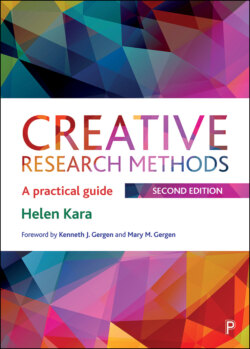Читать книгу Creative Research Methods 2e - Kara Helen - Страница 10
На сайте Литреса книга снята с продажи.
ОглавлениеDebts of gratitude
So many people have helped with the creation of this book that I can’t name them all. Inspiration and ideas have come from one-off conversations on buses and at conferences; from ongoing discussions with members of the UK’s Social Research Association, the British Library’s social science department and the members of the Arts & Sciences Researchers Forum at Cambridge University; as well as from innumerable exchanges on Twitter. I’m going to thank as many people as I can, but if you should be in here and I’ve left you out – well, that will be the first of the mistakes in this book which are, of course, all my own responsibility.
For specific advice on quantitative methods, I’d like to thank Andrea Finney from the School of Geographical Sciences at Bristol University, and Patten Smith and Chris Perry from Ipsos MORI. I’m grateful to Elizabeth Rodriguez, aka @LibbyBlog, for pointing me to the crocheted model of hyperbolic geometry. Phil M. Jones, lecturer in policing at Derby University, was invaluable in assisting my thinking for the second edition.
Special thanks for expert advice to Radhika Holmström, who helped with the section about working with the mainstream media, and to Caroline Beavon, who helped with the presentation chapter.
I am very grateful to three artist/researchers and endlessly patient sounding-boards: Carol Burns, Su Connan and Anne-Louise Denyer. Also to Nick Dixon, who pointed me to the work of David Edwards, which I wouldn’t otherwise have found, and who deserves extra special thanks for listening to me go on and on about the first edition of this book for months and months. Online and other resources were provided by Rosalind Edwards, Hazel Larkin, Margy MacMillan, Amanda Taylor, Pat Thomson and other excellent tweeps. Janet Salmons has been enormously supportive from across the Atlantic.
I’m really grateful to Leigh Forbes for moral and technical support. Also to Rob Macmillan of the Third Sector Research Centre, University of Birmingham, for ongoing support and for straightening out some of my tangled ideas about theory. And to Annette Markham of Aarhus University for taking an interest purely on the basis of a slightly cheeky e-mail, and passing on some really helpful information.
The first edition of this book alerted Richard Phillips, geographer extraordinaire from Sheffield University, to my existence. We are now co-conspirators in writing, thinking and occasional wine drinking. His fingerprints are all over this second edition; invisible to you, perhaps, but highly visible to me. I am grateful to him for asking me to work with him (and paying!), influencing my writing and thinking in positive ways and providing regular cerebral and physical sustenance in Sheffield and London.
I am also very grateful for the help and support of colleagues at the National Centre for Research Methods (NCRM), where I was a Visiting Fellow from 2015 to 2019, and at the University of Manchester, where I have been an Honorary Senior Research Fellow since 2019. In particular, Rosalind Edwards at NCRM and Lisa Williams at Manchester have been unfailing in their support for my work.
My family are hugely supportive: Mark Miller, Julie Miller, Rosalind Round, Jamie Round, Dave Round, Clare Miller, David Miller, Vicki Miller, Bob Denyer, Lauren Denyer, Marie-Claire Denyer, John McCormack, Anne-Louise Denyer, Lowell Black and Aaron Stevenson have all provided encouragement and love.
My friends, too, have been loving, supportive and encouraging. In particular: Ian Bramley and Kevin Turner, Gilly and Dave Brownhill, Carol Burns, Zoë Clarke, Su Connan, Anne and Mike Cummins, Nick Dixon, Leigh Forbes, Sue Guiney, Radhika Holmström, Sarah-May Matthews, Lucy Pickering, Clare Sudbery and AllyFogg, Wayne Thexton and Katy Vigurs.
My partner, Nik Holmes, has helped far more than he realises, by making my life run smoothly and happily in a hundred different ways, such as fixing computer glitches, cooking delicious dinners and giving the best hugs.
This book is immeasurably better as a result of input from four proposal reviewers and especially two typescript reviewers for the first edition, and four proposal reviewers and especially three typescript reviewers for the second edition. All did their job perfectly, praising the good bits and gently pointing out where and how improvements could be made.
Many of the staff at Policy Press helped with the first edition, particularly Ali Shaw, Julia Mortimer, Emily Watt, Victoria Pittman, Laura Vickers, Dave Worth, Jo Morton, Kathryn King, Rebecca Megson and Helen Cook. For the second edition at Policy Press, Catherine Gray deserves special thanks for getting it off the ground and helping me figure out the new structure; Philippa Grand for expert handling of the later stages of the work; Amelia Watts-Jones for excellent administrative support; and Phylicia Ulibarri-Eglite for marketing. I’d also like to thank the world’s best copy-editor Judith Oppenheimer, who once again has saved me from several bloopers. I’m grateful to Emma Wright, aka @editorialgirl, for designing my website and blog (www.helenkara.com / www.helenkara.blog) and helping a great deal with my promotional work.
These few words seem like utterly inadequate recompense for the time, care and expertise all these people have put into my work, but I hope that the knowledge that I am really very grateful for their contributions will go some way towards rewarding their generosity. Also, I hope that when they see – and perhaps even read – the book, they will feel that their input has been well used and their effort worthwhile.
